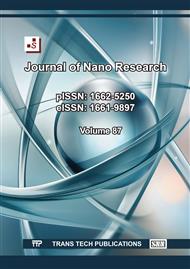[1]
R. Boussetta, O. Mommadi, A. El Moussaouy, M. Hbibi, S. Chouef, C.A. Duque, A. Kerkour El-Miad, Effect of the electric field orientation on stark shift, dipole moment and electronic properties in a circular toroidal quantum ring: Presence of shallow donor impurity, Physica B: Condensed Matter 690 (2024) 416263- 416285.
DOI: 10.1016/j.physb.2024.416263
Google Scholar
[2]
D.A. Ospina, D. Duque, M.E. Mora-Ramos, J.A. Vinasco, A. Radu, R.L. Restrepo, A.L. Morales, J. Sierra-Ortega, G.E. Escorcia-Salas, M.A. Giraldo, J. Montoya-Sanchez, C.A. Duque, Hopf-link GaAs-AlGaAs quantum ring under geometric and external field settings, Physica E 163 (2024) 116032- 116035.
DOI: 10.1016/j.physe.2024.116032
Google Scholar
[3]
L. Seitner, J. Popp, I. Heckelmann, R-E Vass, B. Meng, M. Haider, J. Faist, C. Jirauschek, Backscattering-Induced Dissipative Solitons in Ring Quantum Cascade Lasers, Phys. Rev. Lett. 132 (2024) 043805-043805.
DOI: 10.1103/physrevlett.132.043805
Google Scholar
[4]
M. Kunrugsa, Optical absorption spectra of GaSb/GaAs quantum-ring-with-dot structures and their potential for intermediate band solar cells, J. Phys. D: Appl. Phys. 56 (2023) 435103-435114.
DOI: 10.1088/1361-6463/ace7dc
Google Scholar
[5]
P.K. Yadav, P. Kumar, S. Chandra, V. Kumar, D. Kumar, S.H. Hasan, Carbon quantum dots: synthesis, structure, properties, and catalytic applications for organic synthesis, Catalysts 13 (2023) 422-443.
DOI: 10.3390/catal13020422
Google Scholar
[6]
D.V. Pandi, V. Saraswathi, M.R. Venkatraman, N. Muthukumarasamy, S. Agilan, D. Velauthapillai, K. Brindhadevi, A. Pugazhendhi, PbS quantum dots-sensitized ZnO nanorods-based third generation solar cells, Materials Today Chemistry 29 (2023) 101444-101456.
DOI: 10.1016/j.mtchem.2023.101444
Google Scholar
[7]
A.G. Mirea, I.D. Vlaicu, S. Derbali, F. Neatu, A.G. Tomulescu, C. Besleaga, M. Enculescu, A.C. Kuncser, A.C. Iacoban, N. Filipoiu, M. Cuzminschi, G.A. Nemnes, A. Manolescu, M. Florea, I. Pintilie, Electron transporting bilayers for perovskite solar cells: spray coating deposition of c-TiO2/m-SnO2-quantum dots, Colloids and Surfaces A: Physicochemical and Engineering Aspects 705 (2025) 135508-135519.
DOI: 10.1016/j.colsurfa.2024.135508
Google Scholar
[8]
Y. Ren, L. He, Y. He, Y. Wang, S. Li, L. Zhou, P. Ye, R. Gao, G. Chen, W. Cai, C. Fu, The key role of anti-solvent temperature in quantum dot/perovskite core-shell nanowire array solar cells, Physica E 165 (2025) 116131-116138.
DOI: 10.1016/j.physe.2024.116131
Google Scholar
[9]
A. Mahjoory, K. Karimi, R. Teimouri, R. Mohammadpour, M. Kolahdouz, Thin film Cs2TiBr6 perovskite solar cell incorporating functionalized PbS colloidal quantum dots as a hole transporting layer, Journal of Physics and Chemistry of Solids 196 (2025) 112306-031959.
DOI: 10.1016/j.jpcs.2024.112306
Google Scholar
[10]
H-H Kim, D.H. Kim, B.G. Choi, D.H. Kim, S.D. Oh, D.H. Shin, H. Lee, Enhancement of photovoltaic parameters of thermally stable graphene/LaVO3 semitransparent solar cell by employing interfacial graphene quantum dots, Nanotechnology 35 (2024) 495203-495211.
DOI: 10.1088/1361-6528/ad7b3d
Google Scholar
[11]
H. Yu, Y. Zu, L. Gao, S.Z. U. Din, C. Li, H. Gao, W. Ji, H. Xu, R. Zhai, Z. Jia, X. Feng, J. Liu, Q. Yang, Zero-dimensional lead telluride quantum dots optical modulator for red Pr: YLF ultrashort pulse laser, Optics & Laser Technology 181 (2025) 112003- 111975.
DOI: 10.1016/j.optlastec.2024.112003
Google Scholar
[12]
L. Ye, S. Hong, C. Lu, Q. Zhao, Stable random laser of perovskite quantum dots based on SiO2-QDs-SiO2 composite nanostructure, Journal of Luminescence 277 (2025) 120946-120955.
DOI: 10.1016/j.jlumin.2024.120946
Google Scholar
[13]
S. Rossi, E. T. Simola, M. Raimondo, M. Acciarri, J. Pedrini, A. Balocchi, X. Marie, G. Isella, F. Pezzoli, Electric-field induced modification of the photoluminescence polarization in Ge/Si0.15Ge0.85 quantum wells, Proc. SPIE 12656, (2023) 126560I-1-126560I-6.
DOI: 10.1117/12.2678909
Google Scholar
[14]
D. Bejan, C. Stan, Controlling the interband transitions in a triple quantum ring: Effects of intense laser and electric fields, Journal of Physics and Chemistry of Solids 188 (2024) 111887-111896.
DOI: 10.1016/j.jpcs.2024.111887
Google Scholar
[15]
R. Sellami, A.B. Mansour, M.S. Kehili, A. Melliti, Band alignment transition from type I to type II in GaAs/AlxGa1-xAs quantum ring, Physica E 126 (2021) 114476- 114482.
DOI: 10.1016/j.physe.2020.114476
Google Scholar
[16]
R. Sellami, M.S. Kehili, A. B. Mansour, A. Melliti, Manipulation of linear and nonlinear optical properties of type I and type II quantum ring GaAs/AlxGa1−xAs, Optical and Quantum Electronics 53 (2021) 220-229.
DOI: 10.1007/s11082-021-02863-6
Google Scholar
[17]
The MathWorks Inc. (2022). MATLAB version: 9.13.0 (R2022b), Natick, Massachusetts: The MathWorks Inc. https://www.mathworks.com
DOI: 10.2514/5.9781600861628.0425.0428
Google Scholar
[18]
V.M. Fomin, V.N. Gladilin, S.N. Klimin, J.T. Devreese, N.A.J.M. Kleemans, P.M. Koenraad, Theory of electron energy spectrum and Aharonov-Bohm effect in self-assembled InxGa1-xAs quantum rings in GaAs, Phys. Rev. B 76 (2007) 235320-235327.
DOI: 10.1103/physrevb.76.235320
Google Scholar
[19]
R. Chaurasiya, S. Dahiya, R. Sharma, A study of confined Stark effect, hydrostatic pressure and temperature on nonlinear optical properties in 1D GaxAl1-xAs/GaAs/GaxAl1-xAs quantum dots under a finite square well potential, Nanosystems: Phys. Chem. Math. 14 (2023) 44-53.
DOI: 10.17586/2220-8054-2023-14-1-44-53
Google Scholar


